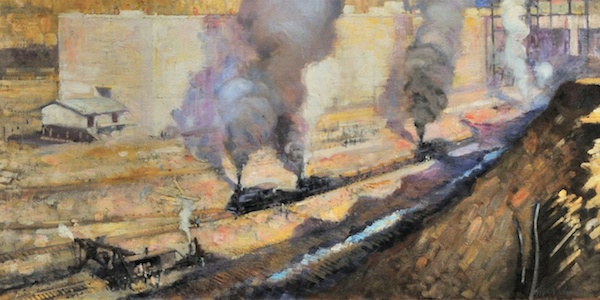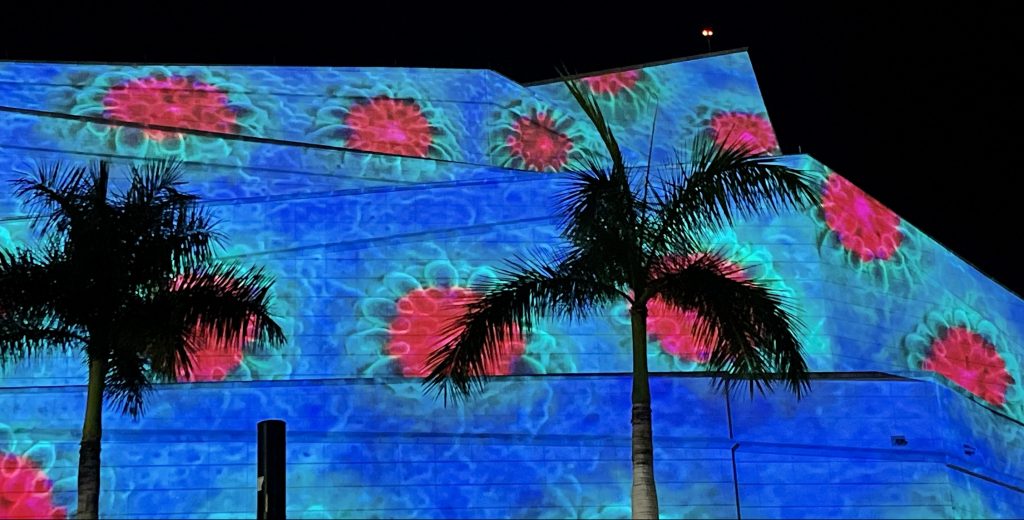
Preparing for “Connecting the World: The Panama Canal at 100” at Charlotte’s Mint Museum
Dr. Jonathan Stuhlman, Senior Curator of American, Modern, and Contemporary Art, The Mint Museum
To most people, September 30 marked the end of the first full week of fall. For me and my colleagues at The Mint Museum, it meant that it was one month and counting until the opening of our upcoming exhibition, Connecting the World: The Panama Canal at 100, here in Charlotte. By the end of the following week, a spotlight version of the exhibition would close its successful run at the Dixon Gallery and Gardens in Memphis, Tennessee, and begin to make its way east to Charlotte under the watchful eye of the museum’s associate registrar, Katherine Steiner. At the same time, more than a dozen other paintings and prints from around the country would begin their journey to Charlotte. On Wednesday, October 1, Elyse Frederick, one of the museum’s talented graphic designers, was in Asheville, North Carolina, to oversee the test printing of the exhibition catalogue. And on that same day, approximately four hours east of Asheville, CNC routers began to buzz at the Stiles Machinery shop in High Point. Meanwhile, at The Mint Museum Uptown in Charlotte, saws and nail guns were hard at work in the level 4 galleries. SEA to SEE, a key part of the exhibition that will make its debut at a media preview on October 30th (and its public debut on November 1), was coming to life.
Alson Skinner Clark In the Lock Miraflores
These efforts, and others taking place across the country, were all being guided by myself and artist Mel Chin and executed by an innovative and dedicated team of individuals that includes leading oceanographers, digital media artists, sound engineers, 3D-CAD designers, CNC machinists, woodworkers, and researchers in an integrated, interdisciplinary approach that has long been a part of Chin’s art. I had approached Chin more than a year earlier when I had the idea that to enliven a planned exhibition of historic images of the Panama Canal, brought together to celebrate the centennial of its opening, the museum should commission a contemporary work of art to connect the present to the past. Chin was a logical choice, not only because of the bold, unflinching look that his work has long taken at history, but also because of the fact that he has been living and working in North Carolina for almost two decades yet has never shown his work at the Mint.
Chin was inspired by the idea of the Canal as a point of connection between the Atlantic and Pacific Oceans, and conceived of SEA to SEE as an installation in which visitors would pass between two 12-foot-tall plate glass hemispheres representing the oceans, much as ships passing through the Canal link one ocean to the other. Yet while these hemispheres are impressive and imposing in their sheer physicality (and their form will reference both latitude and longitude lines on globes and the structure of the Canal’s gridded steel lock gates), this is but one aspect of the piece. FThe hemispheres also will act as screens, upon which are reverse-projected films representing the two oceans that are created by layering various kinds of data made into visual form, drawn from over the past 100 years. Certainly the experience of passing between these glowing orbs will stimulate visitors to think about the effect of the Canal in new ways. But how could we share the exciting process of how this installation came to life; and how could we share it with those who might not be able to see it in person? The Knight Foundation’s grant is enabling us to do just that, expanding our online presence and documenting this important undertaking in new and exciting ways.
When the CNC routers at Stiles Machinery in High Point began cutting the parts for the framework of the hemispheres out of high-end Baltic Birch, Mint employees Scott Queen and Brandon Scott were on hand with the best equipment possible to document the process. The next day, Queen was back in Charlotte setting up cameras in the gallery where the framework to house these hemispheres (once they are constructed) was rising. I’d seen the concept drawings and knew how large these “frames” would be but seeing them in person, rising 14 feet to the gallery’s lighting grid, was still shocking. Even at this point I could tell that the experience of passing through SEA to SEE was going to be truly intense and certainly unforgettable. Queen set up cameras that will allow the museum to live-stream much of the installation process once things begin to take shape within the hemispheres’ frames. He also continued documenting the construction process.
Today Chin and his team of Severn Eaton, Anna Glick, and Maria Perry arrived to begin the process of freeing the pieces of the hemispheres from the sheets of plywood and begin assembling them. This week Chin will also work with Charlotte video artist Ben Premeaux on the projection technology, using specially-made lenses to fill the hemispheres with dazzling color and light. By the end of the week (we hope) the modular framing elements of the hemispheres will be assembled and sent off to be painted. Next week, the custom bent glass will arrive from Flickinger’s Glassworks in Brooklyn, New York. Everything will be assembled and eased into place. Oh, and the art will arrive. As will a five-ton bucket from a steam shovel that worked in Panama, sent from the Nederland Historic Society in Colorado. And the catalogues. And thanks to our grant from the Knight Foundation, visitors to our website will be able to see much of it happening in real time. And the footage that we have compiled will be edited into a time-lapse video that will endure even after the show closes. It’s perhaps the most stressful time to be the curator of a project like this. Lots of parts are moving. But it’s also the most exciting. It’s where the ship sets sail and the project comes to life. It’s go time!
Recent Content
-
Artsarticle ·
-
Artsarticle ·
-
Artsarticle ·
